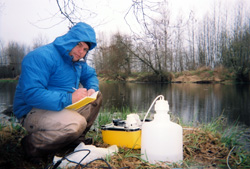Nitrogen Management
Introduction
Excess nitrogen from fertilizer, animal wastes, sewer lines, and atmospheric deposition can cause deleterious effects to drinking water supplies and alter ecosystem function. EPA researchers evaluate ecological restoration as a means to enhance nitrogen removal through biogeochemical pathways like denitrification. Denitrification occurs when nitrogen-rich water interacts with surface and subsurface substrate. The substrate, or underlying layer, supports the microbial community and the environmental conditions needed to convert nitrate to dinitrogen gas. Thus, restoration activities can be enhanced by promoting habitats and conditions that support denitrification or other biogeochemical removal pathways. To identify restoration activities that can enhance nitrogen-removing ecosystem services, nitrogen processing research is being conducted in the following areas of the United States: Baltimore, Maryland – Minebank Run
Coburg, Oregon – Green Island
Lancaster County, Pennsylvania – Big Spring Run
Nitrogen processing, denitrification, and assessment of the drivers and limitations of denitrification are critical components of these studies. Results will help develop ecologically based guidelines for stream and floodplain restoration that can improve ecological health, water quality, and illustrate the ecosystem services of river and stream ecosystems. ProductsForshay, K.J., B. Faulkner, P.M. Mayer, and S.P. Cline. (2009). “Low-Elevation Inland Habitats of the Willamette River Floodplain Support Enhanced Denitrification.” Presentation, 94th Ecological Society of America Annual Meeting, Albuquerque, New Mexico, August 2–7. Faulkner, B.R. (2008). “Bayesian Modeling of the Assimilative Capacity Component of Nutrient Total Maximum Daily Loads.” Water Resources Research, 44: W08415. doi:10.1029/2007WR006638 Clark, J.E., E.C. Hellgren, E.E. Jorgensen, et al. (2003). “Population Dynamics of Hispid Cotton Rats (Sigmodon hispidus) Across a Nitrogen-Amended Landscape.” Canadian Journal of Zoology, 81: 994–1003. Jorgensen, E.E. Advances in Restoration Science, Number 2: Opportunities in Nitrogen Management Research: Improving Applications for Proven Technologies and Identifying New Tools for Managing Nitrogen Flux and Input in Ecosystems – Issue Paper (6 pp, 128 KB) (EPA/600/S-02/003) June 2002 ContactKen Forshay, Ecologist |
![[logo] US EPA](../gif/logo_epaseal.gif)
